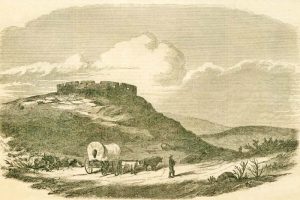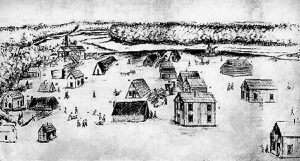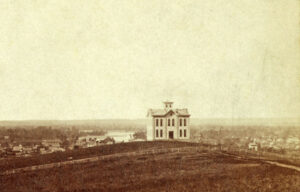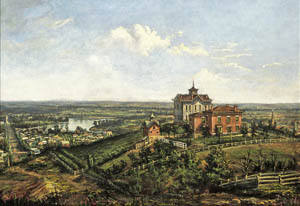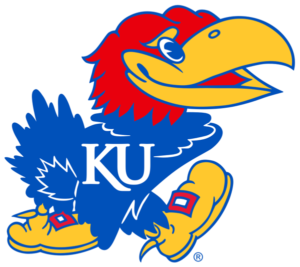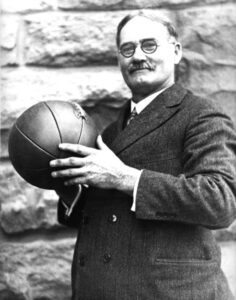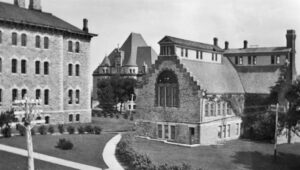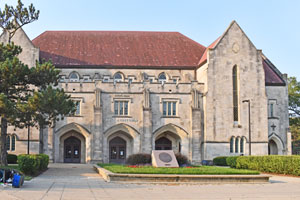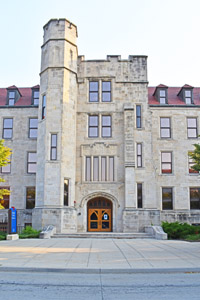
University of Kansas in Lawrence, Kansas, by Alfred Lawrence, 1913.
The University of Kansas, located in Lawrence, Kansas, is a public institution with several satellite campuses, research and educational centers, medical centers, and classes throughout the state.
The university, often referred to as “KU,” formally opened its doors to students in September 1866, but its history dates back to 1855. At that time, the first legislature made a provision for a Kansas university, with buildings to be erected when Congress or benefactors would give money for their construction.
In 1856, Amos A. Lawrence instructed Dr. Charles Robinson, the agent of the Emigrant Aid Company at Lawrence, to erect a building for a school preparatory to a college or university. Amos Lawrence of Boston, Massachusetts, in whose honor the town of Lawrence was named, made plans for a college on the north end of Mount Oread, a hill west of the town. He provided notes and stocks valued at $12,696 to support the foundation of his proposed “Free State College.” This money was to be held in trust, and the income was “to be used for the advancement of religious and intellectual education of the young in Kansas Territory.” However, an imperfect deed to the land caused Mr. Lawrence’s plans to be delayed.
In 1858, the Presbyterian Church of the United States established a school on Mount Oread, believing that Mr. Lawrence’s funds could be secured to help it. In 1859, the legislature granted a charter to this institution under the name of “Lawrence University,” and a board of 22 trustees was appointed. In January 1859, the city of Lawrence provided a quitclaim deed of 40 acres to the trustees of the North College campus. The deed required several conditions, including that the university would be permanently located in Lawrence, that a brick building not less than 36 feet in width and 60 feet in length and two stories high be erected and completed within one year from the date, and that the school would be commenced within six months.
The Presbyterian Board of Education contributed $2,000 toward erecting a college building. Contributions from citizens enabled the trustees to lay the foundation for the building known as the North College on Mount Oread.
To meet the deed’s conditions, a preparatory school called the “University of Lawrence” was opened in the basement of the Unitarian Church on April 11, 1859. However, it was discontinued three months later because there were no students. However, the Presbyterians continued with their building until winter. The following year, 1860, proved to be a difficult time, so their project was abandoned until more funds could be raised.
In the meantime, the Congregationalists appeared on the scene with the idea of building a “monumental college, commemorating the triumph of liberty over slavery in Kansas.” Mr. Lawrence, through his trustees, agreed to give the college his fund if it were to be under Congregational jurisdiction. However, when the Civil War erupted, the Congregationalists’ plans were temporarily ended, and they later established a school in Topeka.
At this point, work on the building was suspended due to a lack of funds, and a new organization was established under the control of the Protestant Episcopal Church. On January 9, 1861, the Legislature granted a new charter to the university, and its name was changed to “Lawrence University of Kansas.” On January 29, 1861, Congress set aside and reserved 46,080 acres of land for the use and support of a State University in Kansas.
Fresh contributions were received from various sources, enabling the new trustees to proceed with and complete the construction of the building. The tower was 50 feet square, three stories high, and contained 11 rooms.
The university was permanently located on November 2, 1863, and in 1864, the legislature passed a law organizing it. The institution’s governance was vested in a board of regents, consisting of a president and 12 members appointed by the governor. Six departments were initially named as composing the university, including the Department of Science, Literature, and the Arts; the Department of Law; the Theory and Practice of Elementary Instruction; the Department of Agriculture; and the Normal Department.
Work commenced at North College in September 1865 and was finished in September 1866. The preparatory school’s first session opened on September 12, 1866, with 26 young women and 29 young men registered during the first term. It was one of the earliest public institutions in the United States to admit men and women equally. The second year showed a marked growth in numbers, with 105 students.
Initially, the course of study leading to a Bachelor of Arts degree required seven years — three years in the preparatory school and four in the college. It was hoped to abandon the preparatory department quickly, but 25 years passed before it was accomplished. It was not until 1869 that collegiate-level courses were taught. The first class of four members graduated in 1873. Several changes occurred in the first years.
Reverend R.W. Oliver, the rector of the Protestant Episcopal Church of Lawrence, who had been elected chancellor in March 1865, resigned in the fall of 1867. In December 1867, General John Fraser, president of the Agricultural College of Pennsylvania, was elected chancellor of the university. The erection of Fraser Hall, the first building on the present university campus, marks his term of service. When Chancellor Fraser resigned on April 15, 1873, there were 173 students enrolled and 11 instructors employed.
A normal department was established in 1876 and remained in operation for several years. In November 1878, the law school was opened, with 13 students enrolled.
In 1880, a preparatory medical course was started under the administration of the College of Liberal Arts and Sciences.
In 1890, F. H. Snow was elected chancellor, and by the close of the school year, 508 students were enrolled in all departments, 36 professors were employed, and five buildings were fully occupied.
At about this time, the university received two very substantial monetary gifts. One was made by Colonel John J. McCook of New York City to encourage athletics among the students. With this money, a tract of 12 acres was secured, graded, and fenced for an athletic ground and given the name of McCook Field.
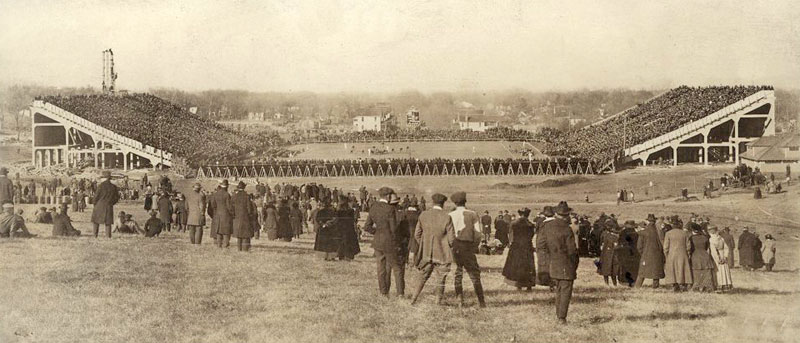
KU Football Game, 1921.
KU began its football program at Baldwin, Kansas, on November 22, 1890. The Topeka Daily Capital reported that Baker University defeated Kansas University 22 to 9. The Weekly University Courier said the Baker-KU contest was the “first football match of any importance.”
The university became known over the years for its strong athletic programs. KU’s mascot has long been the Jayhawk, named for the Kansas Free State supporters who battled the Missouri pro-slavery forces along the border during Bleeding Kansas.
In 1891, the preparatory department was eliminated, and the college was reorganized with a school of arts and schools of engineering, law, fine arts, and pharmacy.
In 1894, Spooner Library and the chancellor’s residence were erected through the generosity of another large donor.
James Naismith, who had invented the game of basketball in 1891, joined the KU faculty in 1898 to coach basketball, teach physical education, and serve as chaplain. At that time, basketball was regarded in Kansas as a woman’s sport after coeds had experimented with the game in 1896. Naismith was surprised by the game’s popularity, commenting that wrestling was a better exercise and that he enjoyed watching gymnasts as much as basketball. However, by the turn of the century, enough colleges had basketball teams that made intercollegiate competition possible. Forrest “Phog” Allen, one of Naismith’s students, became known as the father of basketball coaching.
The steady growth of the university under the leadership of Chancellor Snow increased the demand for equipment. Blake Hall, dedicated to the study of physics and electrical engineering, was completed in 1895. Shops were subsequently erected for engineering students, and “The Fowler shops” were ready for use in 1899. The same year, the school of medicine was established, and the legislature was asked for two new buildings: a chemistry building and a natural history museum.
In 1899, Simeon B. Bell provided the university with money and land in Rosedale (Kansas City, Kansas) under the condition that the university’s medical school hospital be constructed there. Soon, the school of medicine was organized. The scientific department, covering the first two years of the course, was established in Lawrence, and the clinical department was located at Rosedale.
By 1900, the campus had grown to 50 acres with nine instructional buildings and 1,294 students. The years of Mr. Strong’s administration were years of expansion. In 1902, the first summer school session was held. In the next decade, the number of buildings grew to 20, including the Natural History Museum, Green Hall, the Eleanor Bell Memorial Hospital, and the Robinson Auditorium-Gymnasium. The campus also grew to 163.5 acres, which a landscape gardener laid out. Potter Lake, near the west side, was constructed in 1910-11 for fire protection and ornamentation.
As enrollment increased, more courses of study were added. The new departments were education, university extension, home economics, and industrial research. The university also circulated several publications. In 1911, the library boasted 5,000 volumes and 40,000 pamphlets. The number of instructors was 146.
The clinical department of the medical program was reorganized in the fall of 1905 through the merger of the Kansas City Medical College, founded in 1897; the Medico-Chirurgical College, founded in 1896; and the College of Physicians and Surgeons, founded in 1894. The hospital building was erected, and the department was opened in 1906. The training school for nurses in connection with the hospital was established in July of the same year.
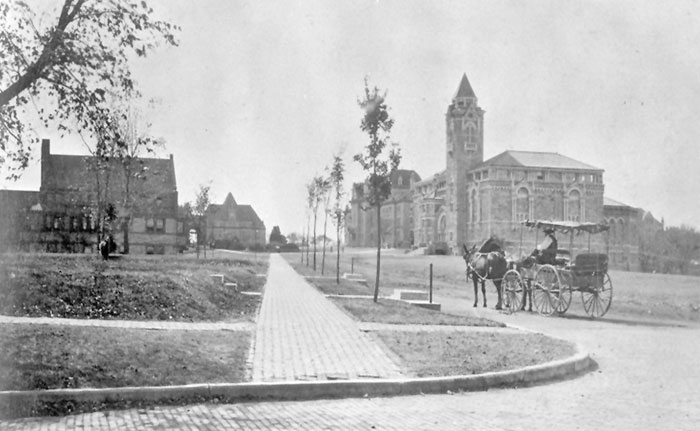
KU Campus Scene, 1910.
A new hospital was built in the summer of 1911. That year, about 2,400 students enrolled in all departments.
During World War II, Kansas was one of 131 colleges and universities nationwide that participated in the V-12 Navy College Training Program, which offered students a path to a Navy commission.
Today, the University of Kansas continues to influence some 28,000 students each year at its Lawrence campus, as well as satellite campuses, research and educational centers, medical centers, and classes across Kansas. The original campus is now the University of Kansas Historic District, occupying 85 acres with 52 resources—buildings, landmarks, and landscapes. Six of the buildings, covering the period of 1863-1951, are individually listed in the National Register of Historic Places.
In 2016, enrollment at the Lawrence and Edwards campuses totaled 28,401 students; an additional 3,383 students were enrolled at the KU Medical Center, resulting in a combined enrollment of 31,784 students across the three campuses. The university employed 2,814 faculty members in the fall of 2015.
KU is home to the Robert J. Dole Institute of Politics, the Beach Center on Disability, the Lied Center of Kansas, and radio stations KJHK, 90.7 FM, and KANU, 91.5 FM. The university hosts several museums, including the University of Kansas Natural History Museum and the Spencer Museum of Art. The university libraries include Watson Library, Kenneth Spencer Research Library, Murphy Art and Architecture Library, Thomas Gorton Music & Dance Library, and Anschutz Library. Of athletic note, the university is home to Allen Fieldhouse, heralded as one of the most significant basketball arenas in the world, and David Booth Kansas Memorial Stadium, the eighth-oldest college football stadium in the country.
More Information:
University of Kansas
1450 Jayhawk Blvd., Lawrence, KS 66045
785-864-2700
©Kathy Alexander/Legends of America, updated September 2025.
Also See:
Bleeding Kansas & the Missouri Border War
Lawrence, Kansas – From Ashes to Immortality
Sources:
Blackmar, Frank W.; Kansas: A Cyclopedia of State History, Vol I; Standard Publishing Company, Chicago, IL 1912.
Cutler, William G.; History of Kansas; A. T. Andreas, Chicago, IL, 1883.
Kansapedia
Wikipedia

